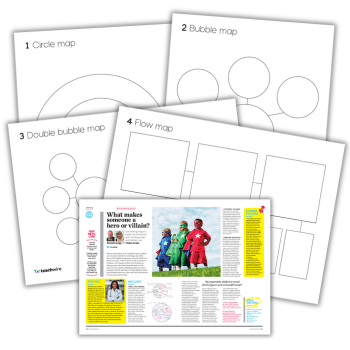What Can A Specialist Setting Teach Primaries About SEND Provision?

It might be a well-resourced specialist setting, but Westmorland School can still teach mainstream primaries a great deal, as Sal McKeown discovers…

- by Teachwire
- Classroom expertise and free resources for teachers

Westmorland School, part of the specialist education and care provider Witherslack Group, is a co-educational primary school in Chorley, Lancashire. Judged outstanding by Ofsted, the school has also received Autism Accreditation from the National Autistic Society.
“Andrea Smith has been the SENCo at Westmorland School since 2013, after moving from a mainstream primary school near Rochdale. Westmorland offers much more in the way of specialist support compared with mainstream provision, employing its own speech and language therapists, an occupational therapist, an educational psychologist and mental health practitioners. There is also a dedicated pastoral staff that meets as a team once a week to discuss issues such as SEN referrals and plan interventions.
A briefing session at the beginning and end of each school day helps everyone keep tabs on pupils who are giving cause for concern. “In mainstream, when we needed a speech and language therapist it would take weeks to get one into school,” Andrea remembers. ‘Now I’m surrounded by an in-house team of experts.”
Overactive and under-responsive
Many children at Westmorland have sensory processing difficulties. If a child is disturbed by different textures, becomes overwhelmed when there is too much noise or visual input or can’t cope with strong smells, the school’s OT will assess their needs and provide recommendations through individualised ‘sensory diets’ and environmental adaptations.
Some classrooms are specifically designed as low sensory environments, containing workstations and a safe space that children can escape to if they are feeling overwhelmed. Children in the main building can meanwhile use one of the school’s ‘contemplation’ rooms to take time out from the classroom
While some children may overreact to sensory input, others will be under-responsive. To counteract this, the OT oversees a programme of Movement Breaks, which Andrea uses to encourage alertness among pupils and can involve moving, stretching, practising dance moves or doing press ups against the wall.
The school’s curriculum places a strong emphasis on social communication. Every half term there’s a focus on how teachers can support children’s communication skills in a particular way – past examples have included teaching children about the importance of making eye contact, being able to share and being willing to take turns – so that there’s a consistent message running through all lessons.
Approaches that work
Although Andrea is aware that Westmorland School is exceptionally well resourced with a low pupil to staff ratio, she explains that there are many simple things mainstream settings can do to make a real difference for children with autism.
Most schools admittedly don’t have safe spaces or sensory rooms, but Andrea has found that providing a child with ear defenders can reduce their sensitivity to noise, while a big cardboard box in a corner can be a decisive factor in whether a child stays in class or takes flight. ‘They need a little space and time to become calm,’ she says, “but you don’t necessarily need a purpose-built or expensive space.”
Concrete examples
Seating can be crucial. For children with ADHD who have problems sitting still, a chair that rocks may help them to focus on the lesson rather than their physical discomfort. Even something as simple as a cushion can have real benefits for a child who dislikes sitting on hard surfaces.
Providing pencils of different widths can further help with developing children’s fine motor skills, while using pencil grips will help to discourage some pupils from gripping their pencils too tightly. As the grips cause their hands to relax, their muscles won’t be as strained, enabling them to write more successfully.
Children with autism frequently have strong interests that can be used to good effect. One of the boys at Westmorland, for example, is very keen on the video game character Mario and more likely to compete worksheets with ‘Mario Says…’ printed at the top. At other times, the teaching of concepts such as Venn diagrams have proved more effective when the pupils are asked to sort items that relate to their interests, such as trains or dinosaurs.
Teachers at Westmorland typically model what they want the children to do. As Andrea explains, “We might have a picture of a fair or the beach and talk about what we might see, hear, smell, touch and taste. We’ll gather ideas together on the flipchart, and using suggestions from class discussion, I’ll model sentences such as, ‘When I got to the funfair the lights were as bright as fireworks’. Children who struggle to process language or use their imagination fare better if they have concrete examples to work from.”
The teachers also help personalise learning using iPads. The pupils enjoy using Book Creator, an app that lets them bring together text, images and sounds. Some of the more creative children can get carried away with using the app’s sound effects, however, prompting Andrea to concede that if the task is intended to develop or assess literacy writing skills, they do need to actually write something! “We don’t use technology for every activity,” Andrea notes. ‘If using the iPad is no better than pencil and paper, then we will use pencil and paper.”
Learning to thrive
Children thrive when lessons are structured and they know exactly what they must do. This affects the way activities are run – a reading task, for example, can be broken down into four or five steps that pupils tick off as they compete each stage.
Westmorland pupils also get to experience ‘Choosing Time’ at the end of most lessons. Sometimes this might again relate to a pupil’s special interest in the form of a treat or relaxation break after a concentrated spell of work; on other occasions, a canny teacher may suggest a choice of three activities that help the children to consolidate their learning.
SENCos in mainstream schools can sometimes feel that they have to fight their corner against other school priorities – especially if they want expensive equipment that will only be used by one or two children. As Westmorland’s SENCo, Andrea is part of the school’s senior leadership team and her skills and knowledge feed into the school development plan. “It works well,” she says. “I can find solutions and implement lots of positive change.”
The TEACCH method
The work done at Westmorland is underpinned by the TEACCH method – ‘Treatment and Education of Autistic and Communication related handicapped CHildren’ – originally developed by Professor Eric Schopler of the University of North Carolina.
Controlling the space
The room needs a clearly defined layout with separate areas for work, play, reading and other activities, while allowing enough space for independent and group work.
Tracking time
A visual timetable should be clearly displayed, showing pupils what will happen and when during their time in school via a series of symbols, photographs or drawings. It ought to include information about which teachers and TAs the pupils will be working with, and may span a day, a week or even just a single lesson.
Promoting independence
Materials should be provided that will allow a pupil work independently. The materials should employ clear and concise language, scaffolding and modelling and break tasks down into separate stages, as seen with Andrea’s reading sheet example.
Find out more about the TEACCH method at autism.org.uk/teacch







